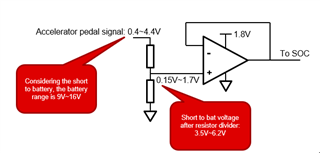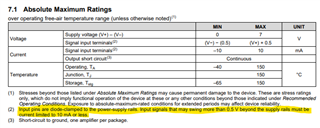Other Parts Discussed in Thread: TLV313
Hi Expert,
My customer is considering to use TLV313-Q1 as a buffer to isolate the short to battery voltage. You can find the block diagram as below. The normal operating input voltage of TLV313-Q1 is about 0.15V to 1.7V. But in customer's use-case, there will have short to battery case. The short to battery voltage range after resistor divider is about 3.5V to 6.2V which is higher than the TLV313-Q1 input common mode voltage. My question is that what is the output value when the short to battery performed? Is it 1.8V?
During the short to battery situation, there is no need for output this value. But customer would like to detect the short to battery situation. If the output value is 1.8V during short to battery happens, customer would like to use 1.8V as a threshold for SOC to detect the short to battery situation.
Do you see any other risks for this use-case?

Thanks!
Ethan Wen






